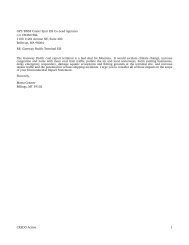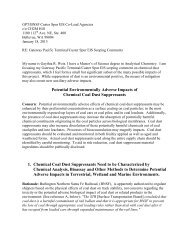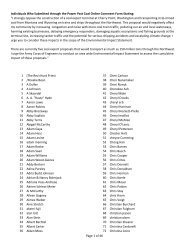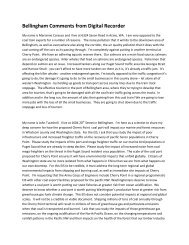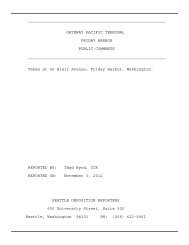Lummi Indian Business Council - EISs for the Proposed Gateway ...
Lummi Indian Business Council - EISs for the Proposed Gateway ...
Lummi Indian Business Council - EISs for the Proposed Gateway ...
Create successful ePaper yourself
Turn your PDF publications into a flip-book with our unique Google optimized e-Paper software.
<strong>Lummi</strong> Nation in particular associated with fishing interference, spills of hazardous materials,ocean acidification, acid rain, visibility impairment (due to sulfur dioxide and nitrogen oxideemissions), sea level rise and all of <strong>the</strong> o<strong>the</strong>r potential impacts associated with <strong>the</strong> proposedprojects.Like all of <strong>the</strong> potential project impacts, <strong>the</strong> analysis of economic impacts should specificallyconsider environmental justice and cumulative effects.10.3 Significant Unavoidable Adverse ImpactsElements of <strong>the</strong> proposed projects will preclude <strong>the</strong> ability and/or interfere with <strong>the</strong> ability of<strong>the</strong> <strong>Lummi</strong> People to exercise <strong>the</strong>ir treaty rights to fish throughout <strong>the</strong>ir U&A. – <strong>the</strong>se impactswill result in significant, unavoidable, and unacceptable interference with our treaty rights andirreversible and irretrievable damage to our spiritual values if <strong>the</strong> proposed projects areapproved.11 Potential Impact: Ballast Water (Water Quality and Invasive Species)11.1 Issue Definition/Rationale:Because as described <strong>the</strong> proposed project will be primarily an export facility, ships calling on<strong>the</strong> facility will need to discharge ballast water. This ballast water can originate from all over<strong>the</strong> world and carry plants, animals, bacteria, and pathogens ranging in size from microscopic tolarge plants and free‐swimming fish. Non‐native organisms and pathogens introduced through<strong>the</strong> discharge of ballast water from vessels calling on <strong>the</strong> proposed facility and/or existingfacilities can significantly alter an ecosystem by competing with, preying upon, and/ordisplacing native or commercial species or invade and destroy <strong>the</strong> habitat that is critical tonative species. The displacement of native species, <strong>the</strong> degradation of native habitats, and <strong>the</strong>spreading of disease can disrupt social and economic activities that <strong>the</strong> <strong>Lummi</strong> Nation and itsmembers rely upon to preserve, promote, and protect our Schelangen (“way of life”).11.2 Extent/Geographic Scale of EvaluationImmediate AreaLocal AreaRegional AreaGlobal AreaThe EIS must address ballast water management, report on <strong>the</strong> adequacy of ballast watermanagement plans, include an assessment of compliance with current and anticipated stateand federal regulations, and identify and require specific actions that should be taken toeliminate <strong>the</strong> threat posed by ballast water discharges.Like all of <strong>the</strong> potential project impacts, <strong>the</strong> analysis of ballast water impacts should specificallyconsider environmental justice and cumulative effects.<strong>Lummi</strong> Nation Scoping CommentsCorps Project Ref. No. NWS‐2008‐260Corps Project Ref. No. NWS‐2011‐325January 201317



